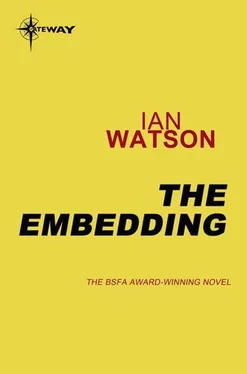Ian Watson - The Embedding
Здесь есть возможность читать онлайн «Ian Watson - The Embedding» весь текст электронной книги совершенно бесплатно (целиком полную версию без сокращений). В некоторых случаях можно слушать аудио, скачать через торрент в формате fb2 и присутствует краткое содержание. Жанр: Фантастика и фэнтези, на английском языке. Описание произведения, (предисловие) а так же отзывы посетителей доступны на портале библиотеки ЛибКат.
- Название:The Embedding
- Автор:
- Жанр:
- Год:неизвестен
- ISBN:нет данных
- Рейтинг книги:4 / 5. Голосов: 1
-
Избранное:Добавить в избранное
- Отзывы:
-
Ваша оценка:
- 80
- 1
- 2
- 3
- 4
- 5
The Embedding: краткое содержание, описание и аннотация
Предлагаем к чтению аннотацию, описание, краткое содержание или предисловие (зависит от того, что написал сам автор книги «The Embedding»). Если вы не нашли необходимую информацию о книге — напишите в комментариях, мы постараемся отыскать её.
The Embedding — читать онлайн бесплатно полную книгу (весь текст) целиком
Ниже представлен текст книги, разбитый по страницам. Система сохранения места последней прочитанной страницы, позволяет с удобством читать онлайн бесплатно книгу «The Embedding», без необходимости каждый раз заново искать на чём Вы остановились. Поставьте закладку, и сможете в любой момент перейти на страницу, на которой закончили чтение.
Интервал:
Закладка:
“Women do not laugh the Soul Laugh, you mean?”
“Consider, Pee-áir, what is a woman, and what is a man. When the man opens his mouth to laugh, if he fails to laugh a strong soul laugh, it may be bad for him. Something evil may rush in past his tongue while his tongue is busy laughing, not speaking words. But what does a woman open, I ask you? Besides her mouth? Her legs. That’s where she keeps her soul word, so that no badness will rush in there. She does not keep it in her mouth. So she can afford to giggle.”
Could it be that this maka-i fungus would cause deformed births? Or acted as some kind of contraceptive? Or maybe caused abortions? With their depleted numbers, small need they have of contraceptives or abortions!
“Do you mean that maka-i makes bad babies?”
He shook his head.
“ That baby—the maka-i child—is not needed.”
“Not needed? You mean maka-i stops babies from coming?”
“I tell you— that baby is not needed. What that is needed, it will come. Then the woman will give birth, laughing.”
But I didn’t understand. Kayapi wandered off, shaking his head at my stupidity, leaving me as bewildered as before. He paddled his feet. I played back some Xemahoa speech, the A and the B varieties—the daily vernacular and the knotty embeddings of the drug speech in which the myths are told—myths which they trust, as Man has always hoped throughout history, will somehow reconcile the irreconcilable realities around them.
“Where’s this tree the fungus grows on, Kayapi?”
He seems to be drawing closer and closer to the Xemahoa, more remote from his mother’s people and all outside concerns. He’s stopping using Portuguese—speaking more and more Xemahoa to me, forcing me to pick it up.
The growing possibility of communion with the tribe—of acceptance, at last—as the water rises, is drawing him deeper into Xemahoa thoughts and ways. Increasingly he finds it unnecessary and undesirable to stay outside the circle like a jackal snatching scraps.
Fortunately I’m picking up almost enough of the ordinary brand of Xemahoa for us to conduct simple conversations in the tongue.
At times I’m afraid—scared to my marrow.
The Makonde tribespeople in Mozambique thought right along my own wavelength compared with these Xemahoa. It’s a different universe of concepts here. A different dimension. A political crime is being committed against them by American capitalism and Brazilian chauvinism and the likelihood of their ever rising up with AK-47S and grenade launchers like the men of Mozambique—of their ever conceiving the political dimension—is zero, nil, less than nil. Yet my feelings of rage and impotence are almost swallowed up in the sense of intoxication about me: the sense of excited anticipation among the Xemahoa. Surely, says my rational mind, this must be an illusion. Surely!
“What is the tree, Kayapi?” I asked in halting Xemahoa.
He shrugged, turned his face away.
“Will the water kill the maka-i plant?”
“It lives in a small place. This much space.”
The space between his outstretched hands.
“Here—and here—this many places.”
He held up his hand in the sign for ‘many’ among his mother’s people—five fingers spread out.
Five seems like many to some people in some cultures. Not to the Xemahoa however—which was what was frustrating about Kayapi making this sign.
Xemahoa, uniquely among Indian tribal languages, has a rich vocabulary for numbers. They are the names of things that contain these numbers in some way or other: for instance a certain macaw’s wing contains so many feathers in it. A different bird has a different number of feathers. Or perhaps I should say, so many feathers that the Xemahoa themselves consider significant.
They hunt these birds for food, and feathers for decoration for the Drug Dance, so that this feather-number system strikes a special chord in their lives. Not in mine, alas. Kayapi looked at his hand making the sign for ‘many’ in disgust, struck it angrily against his side, pronounced the number-word in Xemahoa.
But it was a bird I didn’t know. And anyway I would have had no idea how many wing or tail feathers it had, never mind which of them were significant. I tried asking him in Portuguese, got no response.
“It will die though?”
“Floods come, floods go, it sleeps.”
“This flood won’t go away. This flood is forever.”
“Maybe.”
“How about if the Bruxo took a knife and dug up maka-i and took it somewhere else and put it in the ground again?”
“Dig up a tree? Dig up the jungle? I tell you, you must treat maka-i with courtesy, politeness. You can’t bully him, push him round. He goes away then. He only lives where he chooses—so many places.”
He flashed his hand again. Then said the bird-number. Maybe this bird only had five feathers that counted as significant. Maybe the fungus could only colonize five peculiarly specialized places in this tangled jungle? But how was I to know!
“Show me.” And I said the bird’s name. “Show me that number here in the village. Show me the huts that make up so many.”
I hoped that the circle of the village wasn’t divided up into totem segments, and that this bird didn’t also stand for one of these totem units. If that was the case, Kayapi might point out this bit of the village represented by the bird instead of the number of feather ‘counters’ the bird itself possessed. He gestured vaguely at the village, shook his head.
“Where the Xemahoa live, maka-i lives nearby,” Kayapi said after thinking a while. “We eat the same soil that he eats. And he eats our soil too.”
‘And he eats our soil too.’ Kayapi must be talking about two different sorts of soil—earth, and excrement.
The Xemahoa are among the tribes that eat soil. A special kind of soil, that is. A speckled clay containing some necessary dietary minerals, I suppose. I had tasted some of the clay when Kayapi showed me it. He ate a handful himself. It tasted like cold condensed Campbells corn soup—if you didn’t think of it as ‘dirt’. But did he mean right now that the Xemahoa not only ate the clay where the fungus grew, but also manured the fungus with their own nightsoil?—with their own shit? That seemed to be what he was saying: they were living in a symbiotic relationship with this fungus, just as it was living in a state of ecological symbiosis with its own neighbourhood—with the clay, with the tree roots.
“Kayapi, you feed maka-i your own body soil?”
He nodded, smiling. I’d been intelligent this time, not stupid.
“Bruxo or his boy feeds it. They know the rules of courtesy for offering the food. But it’s the body soil of all the Xemahoa.”
“Including yours too?”
It was a stupid remark. I’d touched a sore nerve there. It made him break off the discussion.
And so to another firelit dance.
The men danced but didn’t actually snort any maka-i this time. Only the Bruxo was high on the fungus powder, chanting the legends. As he chanted I followed him round, recording the singsong jumble of words. Later on, I’d try and organize them into a ‘sensible’ form.
Kayapi was dancing round, but he paid no attention to me.
Firelight flickered on the water—they’d built platforms for the bonfires. Gleams of red and yellow snaked across the ripples their stamping feet set in motion.
After the first hour the Bruxo led them away from the village proper, out to the totem hut where the woman was hidden away making her baby.
Kayapi forgave me today. Maybe he felt closer to the tribe and less insecure after last night’s dance.
“I tell you a story, Pee-áir.”
“Is it the same story the Bruxo was telling last night?”
Читать дальшеИнтервал:
Закладка:
Похожие книги на «The Embedding»
Представляем Вашему вниманию похожие книги на «The Embedding» списком для выбора. Мы отобрали схожую по названию и смыслу литературу в надежде предоставить читателям больше вариантов отыскать новые, интересные, ещё непрочитанные произведения.
Обсуждение, отзывы о книге «The Embedding» и просто собственные мнения читателей. Оставьте ваши комментарии, напишите, что Вы думаете о произведении, его смысле или главных героях. Укажите что конкретно понравилось, а что нет, и почему Вы так считаете.












